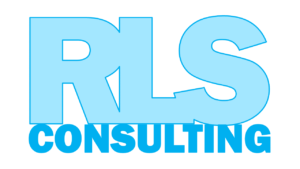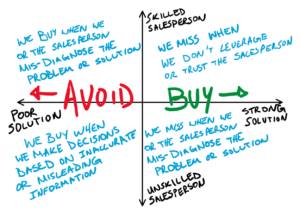Overcoming the Buyer’s Challenge
This article is related to a larger discussion about the “Buyer’s Challenge” and related scenarios that can occur.
In this post, we talk about ways to avoid this and overcome the Buyer’s Challenge.
If you’re just starting here, we are breaking down the challenges that keep buyers from getting to a strong solution, or that would help them avoid a poor solution, by looking at each of 4 different scenarios that can occur.
You can find the previous posts in this analysis here:
Tips to Overcome the Buyer’s Challenge
So, if buyers want to avoid these challenges, there are a few lessons to take away from the analysis we ran through and the anecdotes we discussed.
Most of the issues that come up in the buying/selling process revolve around:
- Poorly understanding the problem analysis and cost to the business
- Weak knowledge around your business, its operations, and related solutions
- Lack of trust or validation within the solution discovery process and your sales counterpart
- Poor communication both externally and internally
Much of this is in the buyer’s hands and empowers them to find the right solution for their company, regardless of who they end up talking to in the sales process – what our overall goal is here.
Your Path to a Short Buying Cycle and Confident Decision
1. Dive deep into analyzing your problem.
Be careful not to stop at the surface level issues – there’s usually an underlying root cause that can be overlooked.
Understand the cost of the status quo – if you want to measure the value of a solution, and budget properly, you need to understand what the problem you are experiencing is costing you. It may not be apparent until you really start to dive in. Measure costs related to time across all related processes, missed opportunities, negative impacts on other business processes, and other gaps when you compare ‘what is’ to ‘what could be’.
2. Educate yourself with caution.
Do initial research to get some ideas of what’s causing your challenges and what solutions are out there.
Don’t get overconfident in your limited research. Don’t expect to become an overnight expert on something your sales counterpart works on daily. If you’re looking for a vendor partner to help you, be ready to lean into them and their expertise. You will want someone that is able to challenge your misunderstandings and help get you on the right track.
Validate what you’ve learned from a vendor. Ask others and continue your own research after you learn more from your prospective partners to make sure everything adds up.
3. Map your solution to your problem.
Once you understand an ideal solution and its benefits, revisit your problem analysis and make sure you understand how it will impact you.
Confirm it addresses the root cause.
Identify suspected outcomes to create measurable success criteria.
Understand the return on investment and the amount of time you will need to see positive results, it may not be immediate, but it may be worth the effort and wait.
Use your analysis to help win over internal stakeholders and decision makers that will eventually need to sign off on a project or budget.
4. Make a confident decision.
Create decision making criteria in advance based on the key aspects of the root problems that must be addressed.
Determine what’s important to you in a solution and a partner.
Meet more of the team behind the solution and delivery when possible (most salespeople are more than happy to pull in others and build a stronger relationship when it makes sense) – just be mindful to do this when you see all other boxes are checked to avoid disrupting people when you aren’t serious about continuing forward.
Negotiate more confidently by being ready to move forward quickly. Leverage your speed for a decision instead of trying to create leverage by withholding critical details related to your challenges or problems – this could harm your future success.
5. Identify your new problems proactively (manage your risks).
Just because you fixed a business problem doesn’t mean you’re home free. By addressing one business constraint, you’ll likely discover the next one. If you can do so proactively, you’ll save yourself a lot of time, stress, and money.
Give some padding to allow for scope creep, hiccups, learning curves, and other ways that your success could be hindered if implementation doesn’t go as smoothly as you’d hoped.
If you’ve done a good job of creating a plan for risks and surprises, you will be able to adapt according to your plan.
6. Prepare for change management.
Identify challenges you can anticipate with implementing a change to your business.
Think about the key individuals this will impact.
Educate these key players on why there is a change and help them get bought into the solution.
Find ways to minimize disruption.
7. Track what happens next.
Measure your progress against the success criteria and key performance indicators you identified prior to starting implementation.
Don’t lose sight of the original problem you were solving and its cost – sometimes we have a funny way of remembering how things were and we forget how bad it was. Keeping track will help keep things in perspective.
Prepare to reassess in the future. With time, new information and innovation may create alternative solutions. New problems may present themselves over time. Keep an open mind when it comes to changes.
Get Help and an Unbiased Perspective
One of the best ways to help find the right solution for your business and avoid possible challenges that come up through the buying process, is to pull in outside help.
RLS Consulting can help you better understand your problems, their cost, solutions that exist, and their value to your business.
Don’t limit the success of your business by going this route alone, we are here to help make the buying process faster and smoother for both the buyer and salesperson by removing obstacles and setting clear decision and success criteria.
Reach out today for more resources and to learn more about how we can advocate for buyers who are exploring solutions to help overcome their business challenges.
Continue Getting Tips
Keep up with new posts about business, buying technology, cybersecurity, and much more by signing up for our newsletter through the form below.
Share

Ryan Smith
Ryan's experience across cybersecurity, sales, insurance, technology, education, and mathematics have helped him become a business-oriented problem solver that can simplify complex topics.
His eclectic and diverse background is now able to be leveraged by businesses that are interested in outside perspectives to help them overcome challenges.
Popular Posts

RLS Consulting Is (Re)Opening for Business!

Cybersecurity Begins at the Individual

The Buyer’s Challenge
Newsletter
Looking for Identity Theft Protection?
RLS Consulting is a proud distributor of defend-id ©.
Learn how protecting your employees from the perils of Identity Theft and Fraud can help your business security and overhead costs.
Want to sell defend-id through your insurance agency?
Learn More


